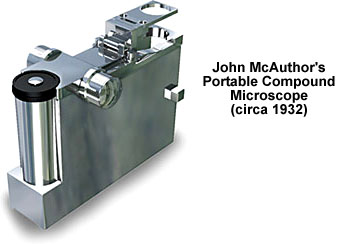McArthur's Portable Compound Microscope
This unusual miniature microscope was designed and built by Dr. John N. McArthur in the early 1930s. After many attempts at perfecting the design using wood, McArthur finally fashioned the completed model, shown here, from chrome plated brass in 1932.

A full description of the microscope is given in the Journal of the Royal Microscopical Society (1934) on pages 182 through 185, and the microscope is also described by Gerard Turner in his comprehensive treatise. The unique design incorporates two prisms that deviate the optical path by 90 degrees on two occasions, a marked deviation from other microscopes of the period. At the front of the microscope, a Huygenian eyepiece is used to view the sample that is positioned face-down on a stage at the opposite end of the rectangular body. There is no mechanism for coarse focus (none is needed), but fine focus is achieved through twin cylindrical knobs that rack the stage up and down. Originally, the microscope was provided with three objectives.
This design was continued long after the second World War, and in 1970, the Council of Industrial Design awarded the microscope it's prestigious Design Award. Gerard Turner reports that the British Open University once used an inexpensive plastic version of this microscope for teaching a biological science course.
BACK TO TWENTIETH CENTURY MICROSCOPES
